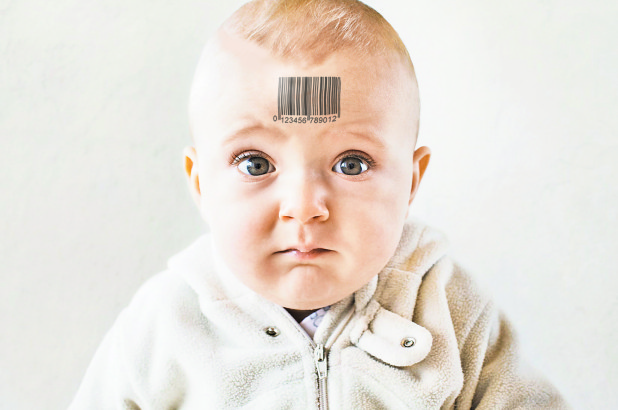Similar to flying cars and memory-erasing neuralyzers, genetically-modified babies might originally sound like something straight out of a futuristic sci-fi film. However, with the rapid advancements of technology in the twenty-first century, “designer babies,” or babies who have been genetically engineered “in vitro” for specially selected characteristics, are already here. In late 2018, a Chinese scientist, He Jiankui, announced the birth of twin girls, Lulu and Nana, whose DNA he claims to have modified using the gene-editing technique CRISPR to give the baby girls HIV resistance, a trait fewer than 1% of people are estimated to have.1 Since Jiankui’s introduction of his designer baby girls into the media, concerns have been raised regarding the ethics of the unusual practice. Designer babies have become an important subject in bioethical debates and questions have been raised about implementing limitations regarding designer babies in the future.
“In vitro fertilization,” or IVF, is a process in which fertilization of the egg takes place outside of the woman’s body. The participant’s ovulatory process is stimulated and monitored, and, when the time is right, an ova or ovum, or the egg, is extracted from the ovaries and fertilized with sperm in a laboratory. The zygote, or fertilized egg, then undergoes embryo culture for two to six days. After this period of time, the zygote is implanted into the participant’s uterus, where it is free to develop and grow as a normal fetus. IVF is usually only frequented by parents who are at risk of having a child with a genetic disease, such as carriers of a monogenic diseases or of chromosomal structural aberrations, or, alternatively, by parents who suffer concurrent infertility or recurrent miscarriages. Preimplantation genetic testing is typically conducted after in vitro fertilization, and involves checking the embryo for any genetic defects. This process is formally called “preimplantation genetic diagnosis.” Only the embryos that are free of defects are finally replaced into the womb.2 IVF in the U.S. averages around $1o,ooo to $15,000, not including additional costs such as medication, genetic testing, etc.3
Though a fairly new subject, the concept of designer babies has been around longer than one would think. One early case of human genetic manipulation took place in 1996, over twenty years ago, when Scott and Monique Collin visited the Genetics & IVF Institute in Fairvax, Virginia. The couple, after the birth of their two sons, wanted to ensure that their third child was a girl, and found the answer to their problem in in vitro fertilization. The team of researchers at the Genetics & IVF Institute, adapting a technique used on livestock, took advantage of a basic rule in biology: girls have two X chromosomes, while boys have one X and one Y chromosome. Because mothers only have two X chromosomes, it’s in the father hands, or rather in the father’s sperm, to bring either an X or Y chromosome to the table, determining the baby’s sex. However, Y chromosomes occur less frequently than X chromosomes. The doctors used this to their advantage and used a light-sensitive nontoxic dye to stain the sperm’s DNA, organizing the sperm by gender before a successful artificial insemination. Prior to the Collins’ case, in vitro fertilization was performed only to address certain medical conditions or diseases.

The Collins’ designer baby procedure entered the public vernacular when they were featured in Time Magazine’s 1999 article, “Designer Babies.” The procedure was met with both praise and criticism. Dr. Zev Rosenwaks, director of the Center for Reproductive Medicine and Infertility at Cornell Medical Center in New York City, responded, “Our view at the moment is that these techniques should be used for medical indications, not family balancing.” Biotechnology critic Jeremy Rifkin, appalled by the concept, added, “It’s the ultimate shopping experience: designing your baby. In a society used to cosmetic surgery and psychopharmacology, this is not a big step.4
CRISPR (pronounced “crisper”) is shorthand for CRISPR-Cas9. CRISPR technology is a powerful tool used by researchers to easily alter DNA sequences and modify gene functions. It allows for the correction of genetic defects, preventing the spread of diseases, and aids in the improvement of crops. CRISPRs are strands of DNA—the protein Cas9 is an enzyme capable of acting as a pair of molecular scissors, one that can accurately cut strands of DNA. Although already fairly powerful, this technology was further adapted by the natural defense mechanisms of bacteria and archaea. These microorganisms use CRISPR-derived DNA and Cas9 protein to prevent attacks from viruses, which they do by cutting up and destroying the DNA of an invader. When these components are transferred to a more complex organisms, it allows for the manipulation, or editing, of genes.5 CRISPR-Cas9 allows the ability to “edit” the DNA sequence of a defective gene by deleting or inserting bases at the zygote stage of embryonic development, potentially ridding not only that person, but also their progeny, of a particular genetic disease.6
Although the use of CRISPR technology to modify embryos, eggs, or sperm is banned in the United States, it is permitted in China. In November 2018, Chinese scientist He Jiankui modified the embryos of seven couples, all of which the males had HIV, during in vitro fertilization. His goal was to remove the pathway through which HIV enters the body by ordering CRISPR-Cas9 to disable a gene called CCR₅, thereby giving the babies HIV resistance. From this procedure came the aforementioned twin girls under the pseudonyms Lulu and Nana.7 Surely this was an accomplishment for Jiankui, but his experiment raised questions and concerns within the science community. Some felt that, when using this technology, there was always the risk of genetically altering genes that weren’t supposed to be modified. Many also emphasized the fact that people with deficiencies in CCR₅ are more susceptible to West Nile Virus and Japanese encephalitis. However, when met with backlash over his controversial project, Jiankui replied, “I understand that my work will be controversial, but I believe families need this technology, and I’m willing to take the criticism for them.”8 Jiankui also spoke on the discrimination HIV-positive people face in China. Despite the backlash, not all people were critical of his project. George Church, a Harvard University geneticist, believes Jiankui’s work was justified, as HIV is a major and growing public health threat. “As long as these are normal, healthy kids, it’s going to be fine for the field and the family,” Church added.9

Jiankui’s project, along with every other case of genetic modification, received a lot of questions and concerns about whether or not it could be morally defended. Although Jiankui’s case only involved disabling CCR₅ and the Collins’ case only involved the selection of gender, they raised issues such as using CRISPR for cosmetic means as well, like choosing eye color, hair color, or height, which many didn’t find morally ethical. The issue of a wider class gap in society was also raised. If genetic modification became a realistic and accessible medical practice, it would create great division between those who could afford a designer baby and those who couldn’t. People fear that the economic division will soon grow into genetic division, with social distinctions and picture-perfect features separating enhanced individuals from unenhanced individuals. The 1997 sci-fi film Gattaca explores this by depicting a society in which only genetically modified individuals, the “valids,” have a place in society’s upper class, whereas those conceived without the aid of genetic selection, the “in-valids,” do not. While these concerns and fears are very valid, the benefits of genetic modification well outweigh the risks.

In a country with already very distinct divisions in social status, the practice of genetic modification would do little to no damage on social class. Nobody wanted to prohibit the introduction of luxury cars or designer bags in America, though they are clearly very ostentatious displays of wealth. Despite the possibility of designer babies becoming just another possession the rich and wealthy can boast about, genetic modification becoming a regular practice in the medical field would only allow for growth in knowledge about genetic diseases. The Council on Ethical and Judicial Affairs released a statement in 1994 in support of using genetic modification to treat, cure, or prevent genetic diseases, but that selection based on benign characteristics is unethical.10 While genetically engineering children to fit into the mold of a “perfect” child is undeniably selfish and unscrupulous, using CRISPR technology for medical advancements is justifiable and defendable. As mentioned before, Jiankui only genetically modified the twin girls’ DNA to remove the pathway through which HIV enters in order to give them HIV resistance—something that wouldn’t have been possible had the children been conceived naturally. Bioethicists also argue that parents have a right to prenatal autonomy, which grants them the right to decide the fate of their children.11 Parents who have lived difficult and expensive lives due to disease should be able to ensure that the same terrible disease isn’t inherited by their offspring. Genetic engineering will give thousands of children the opportunity to live a long and happy life free of the burden of any genetic disease, such as AIDS, blood disorders, muscular dystrophy, and even cancer.12
In the case of modernizing CRISPR technology, the possibility of preventing or reducing the risk of genetic disease far outweighs its moral implications. Genetic engineering, if not used with superficial motives, has the potential to ensure the health of an entire population of children sick with inherited disease. An ethical point of view should not halt the advancements of technology and overall knowledge of biology.
- Carly Stern, “Meet the Chinese Researcher Behind the ‘World’s First Designer Babies,’” OZY (blog), November 28, 2018, https://www.ozy.com/need-to-know/meet-the-chinese-researcher-behind-the-worlds-first-designer-babies/90908. ↵
- Karen Sermon, “Preimplantation genetic diagnosis,” The Lancet 363, no. 9421 (2004): 23. ↵
- Rachel Gurevich, “How Much Does IVF Really Cost?,” VeryWellFamily (blog), March 20, 2019, https://www.verywellfamily.com/how-much-does-ivf-cost-1960212. ↵
- Michael Lemonick, “Designer Babies,” TIME magazine, January 11, 1999, http://content.time.com/time/magazine/article/0,9171,17696-1,00.html. ↵
- Aparna Vidyasagar, “What is CRISPR?,” Live Science, April 20, 2018, https://www.livescience.com/58790-crispr-explained.html. ↵
- Daryl F. Sas and Hannah M. Lawrenz, “CRISPR-Cas9: The Latest Fashion in Designer Babies,” Ethics and Medicine: An International Journal of Bioethics Vol. 33, no. 2 (2017): 81. ↵
- Carly Stern, “Meet the Chinese Researcher Behind the ‘World’s First Designer Babies,’” OZY, November 28, 2018, https://www.ozy.com/need-to-know/meet-the-chinese-researcher-behind-the-worlds-first-designer-babies/90908. ↵
- Carly Stern, “Meet the Chinese Researcher Behind the ‘World’s First Designer Babies,’” OZY (blog), November 28, 2018, https://www.ozy.com/need-to-know/meet-the-chinese-researcher-behind-the-worlds-first-designer-babies/90908. ↵
- Rachel Cocker, “Designer babies are not a health threat, says geneticist,” Daily Telegraph, March 16, 2019, https://www.pressreader.com/uk/the-daily-telegraph/20190316. ↵
- National Center for Biotechnology Information, 1994, s.v. “Ethical issues related to prenatal genetic testing. The Council on Ethical and Judicial Affairs, American Medical Association.” ↵
- National Center for Biotechnology Information, 2002, s.v. “Autonomy and freedom of choice in prenatal genetic diagnosis.” ↵
- Clara Rodriguez Fernandez, “Seven Diseases That CRISPR Technology Could Cure,” LABIOTECH (blog), June 25, 2018, https://labiotech.eu/tops/crispr-technology-cure-disease/. ↵



65 comments
Rinnu Joy
In my opinion, genetic engineering is ethical as well as unethical and it varies according to the context. I would say, in Jainkui’s case he did it for disabling CCR5 which sounds ethical for me. Other cases such as to change eye color, hair color and so on does not mean unethical but it is something that is not necessary. I always support technologies that are used for the good of the society like those to remove genetic diseases such as HIV, AIDS and so on.
Congratulations for the great work!
Lilia Seijas
I found this article made me question if I agree with genetic altering or not. I can see why people would want to remove specific genetic strands that could affect the life of their children, however, I find that removing DNA strands from someone’s DNA is in part removing a part of their history. Although I might be wrong, DNA modification can be risky even if a scientist is just removing the DNA mutations that could affect a baby’s life. Apart from my own personal, I believe this article thoroughly explains both sides to designer babies and their pros and cons and makes the reader think of their own opinions on the subject.
Jesus Parker
If someone was to read this article one hundred years ago they would believe this to be science fiction or just a bunch of nonsense. Technology has come a long ways from what it once was. This article brings up the question, “just because we can do it, should we do it?” To that, I say it is only ethical to use this technology to help with birth defects so the patient has a healthy life.
Kaleb Werku
I think that is only ethical to use this technology to prevent genetic defects and diseases. The thought of people designs their babies is so disturbing to me. We would take one of the most beautiful natural processes in the world and turn it into a game almost. I love technology and all but I would never codon this and I honestly think it should become illegal.
Amelia Hew
Designer babies, in my opinion is only ethical if it’s used to remove genetically illnesses like HIV or chromosome syndromes in order to allow the child to live a healthy and normal life. However, using this technology to create the ‘perfect’ baby? This may cause desperate parents to design their child complete instead of allowing the child to develop on its own in order to ensure that their child can become the top successful person, doing so may also cause parents to abandon child who were ‘imperfect’ and went to get a new one through genetic modification. This act is highly unfair to the unborn child as it’s treating the child as a computer program that can be rewritten till your satisfied instead of a living being.
Sydney Hardeman
This was an interesting article to read because both sides of answering the posed question have potentially strong arguments. While it can be beneficial to have “designer babies” around for the sake of science and medicine, especially when it comes to being immune to certain diseases and conditions, I overall believe that it is an unethical concept because natural birth is the way God intended for things to be and I think “designer babies” might be doing a bit much.
Alin Bocardo Felix
“Designer babies” was originally introduced to me as a concept of the physicality of the baby; as in the eye color, facial structure, hair color, hair structure, body structure, etc. Obviously not exactly it, one can agree it’s messing with nature; but science and technology is advancing, and so the human race must grow alongside it. The 1996 case baffled me, because it is before I was born and it just seems crazy to think that that was possible prior to my birth, when even for me, it’s such a huge concept. ‘Designer babies’, I believe, is a great step into the future, but like everything else, there will be plenty of setbacks before we master the skill. The article is very descriptive in the terminology and it shows the writer knows what they are writing about.
Briley Perkins
I have a read a little bit about genetic designing on babies, or otherwise known as “designer babies”, but it was really interesting to read the entire process of it. On one hand, it would be great to genetically modify because you can avoid the diseases and have the baby have a healthy, but at the same time it could alter different genes that should not be altered. Overall, I feel it is wrong to modify babies, because God should be the one who creates us and it should be kept that way.
Aaron Peters
An interesting but mildly disturbing read, although people may use CRISPR at first to say, fix a birth defect, eventually when the technology further advances, they will use it to essentially build their child from the ground up, which could be dangerous. It seems almost like a form of eugenics, while fixing genetic deformities and diseases is noble, this tech will get out of hand and probably pose a problem to future generations.
Pablo Ruiz
IFV is a process that was unavoidable. The idea of gene editing has always been present and that matter that it is attainable today makes is very new and controversial. I feel that this process will one day become the normal for any individual who wants to conceive a baby because of the randomness of the natural way. In addition, the benefits of IFV can prevent incurable diseases which is a huge plus. This article sheds light on both ends of the spectrum and informs us a lot on the process. As this becomes more popular i feel the controversy will simmer and become normal.